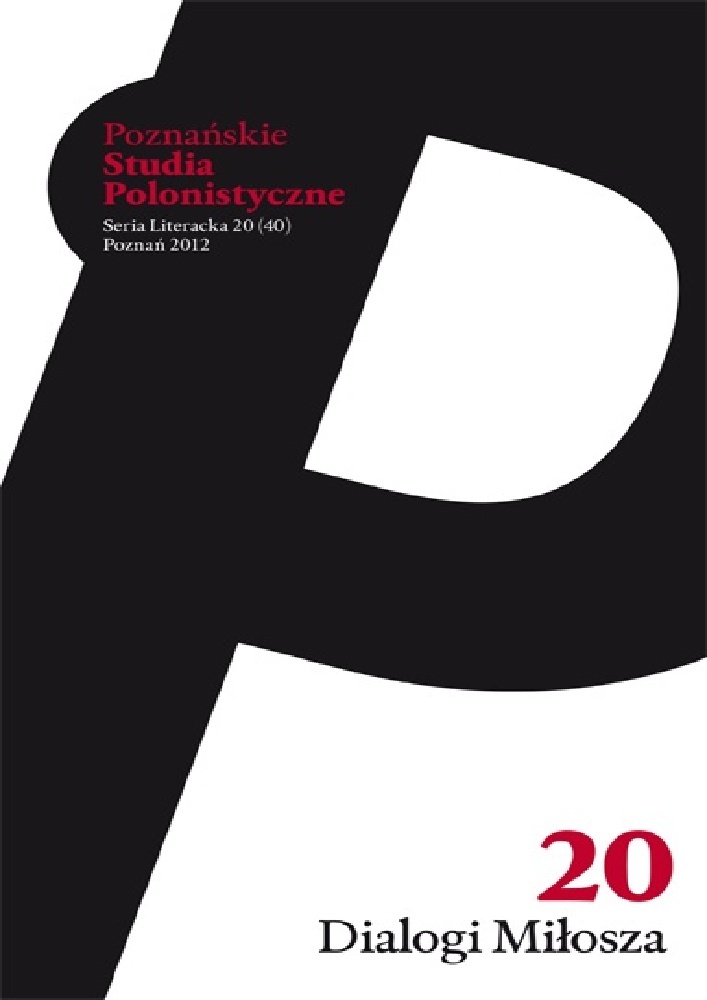Abstract
The article is about the ro numerous researchers, and the direct stimulus for the present author was an extensive and well-informed study by Zbigniew Kaźmierczyk, Dzieło demiurga [Demiurge’s Work], where the critic interprets one of Miłosz’s juvenile collection Trzy zimy [Three Winters] as a record of gnostic experience of existence. Kaźmierczyk, who is a convinced proponent, and competent practitioner of the gnostic key to interpretation of Miłosz’s poetry, presents a highly coherent of Miłosz’s second book of poetry, read through complicated gnostic metaphors, which prevents the critic from a definite description of Miłosz as a gnosticist. The poet is rather describes as only (or so much as) a consciously selective user of imagery typical for gnosticism. Incisive analyses of topics in Trzy zimy, which fill chapter after chapter of Dzieło demiurga, convincingly argue that Miłosz’s juvenile foray into the world of dualistic images was not ephemeric or accidental, but rather had lasting and important consequences. Simultaneously, because of their purity and specific inwardness, they provoke a discussion of the role of this imagery, and the related convictions, in Miłosz’s post-war work, when he wrote Rescue; this issue is presented extensively in the article. The absorbing and fascinating description, fascinating in itself, of Miłosz’s juvenile imagination, presented by the author of Dzieło demiurga, is presented as a perfect background for discussion of further Manichean themes in Miłosz’s poetry. In a wider context, the article presents also the basic anthropological problems in Miłosz’s work, problems that arise from his juvenile experience of Weltschmerz, and which he radically overcame in his later years.References
Błoński J., Epifanie Miłosza, w: Poznawanie Miłosza. Studia i szkice o twórczości poety, red. J. Kwiatkowski, Kraków 1985.
Czarnecka E. [Gorczyńska R.], Podróżny świata. Rozmowy z Czesławem Miłoszem. Komentarze, New York 1983.
Jonas H., Religia gnozy, przeł. M. Klimowicz, Liszki 1994.
Kaźmierczyk Z., Dzieło demiurga. Zapis gnostyckiego doświadczenia egzystencji we wczesnej poezji Czesława Miłosza, Gdańsk 2011.
Miłosz C., Czego nauczyłem się od Jeanne Hersch?, w: Wiersze wszystkie, Kraków 2011.
Miłosz C., Notatnik: Brzegi Lemanu, w: Wiersze wszystkie, Kraków 2011.
Miłosz C., Po odcierpieniu, w: Wiersze wszystkie, Kraków 2011.
Miłosz C., Postscriptum, „Teksty Drugie” 1990, nr 5/6.
Miłosz C., Saligia, w: Ogród nauk, Lublin 1991.
Miłosz C., Zdarzenie, w: Wiersze wszystkie, Kraków 2011.
Miłosz C., Zejście na ziemię, „Pióro” 1938, nr 1.
Miłosz C., Ziemia Ulro, Kraków 1994.
Opacka-Walasek D., Apokatastaza w poezji Czesława Miłosza, w: Chwile i eony. Obrazy czasu w polskiej poezji drugiej połowy XX wieku, Katowice 2005.
Sienkiewicz B., Wątki manichejskie w poezji katastrofistów lat trzydziestych. „Przegląd Religioznawczy. The Religiosus Studies Review” 2008, nr 3 (229).
Wittlin J., Blaski i nędze wygnania, w: Orfeusz w piekle XX wieku, Kraków 2000.
Wyka K., Ogrody lunatyczne i ogrody pasterskie, w: Poznawanie Miłosza. Studia i szkice o twórczości poety, red. J. Kwiatkowski, Kraków 1985.
License
Authors
Authors of texts accepted for publication in „Poznańskie Studia Polonistyczne. Seria Literacka” are required to complete, sign and return to the editor's office the Agreement for granting a royalty-free license to works with a commitment to grant a CC sub-license.
Under the agreement, the authors of texts published in „Poznańskie Studia Polonistyczne. Seria Literacka” grant the Adam Mickiewicz University in Poznań a non-exclusive, royalty-free license and authorize the use of Attribution-NoDerivatives 4.0 International (CC BY-ND 4.0)Creative Commons sub-license.
The authors retain the right to continue the free disposal of the work.
Users
Interested Internet users are entitled to use works published in „Poznańskie Studia Polonistyczne. Seria Literacka” since 2016, for non-commercial purposes only, under the following conditions:
- attribution - obligation to provide, together with the distributed work, information about the authorship, title, source (link to the original work, DOI) and the license itself.
- no derivatives - the work must be preserved in its original form, without the author's consent it is not possible to distribute the modified work, such as translations, publications, etc.
Copyrights are reserved for all texts published before 2016.
Miscellaneous
Adam Mickiewicz University in Poznań retains the right to magazines as a whole (layout, graphic form, title, cover design, logo etc.).
